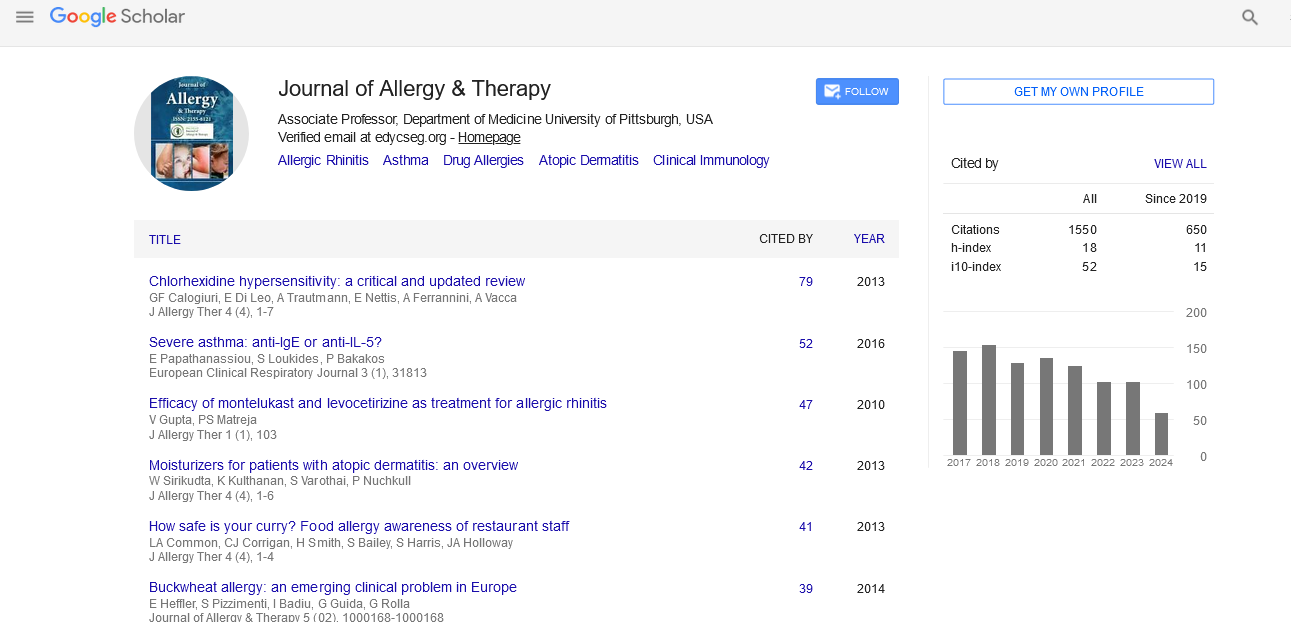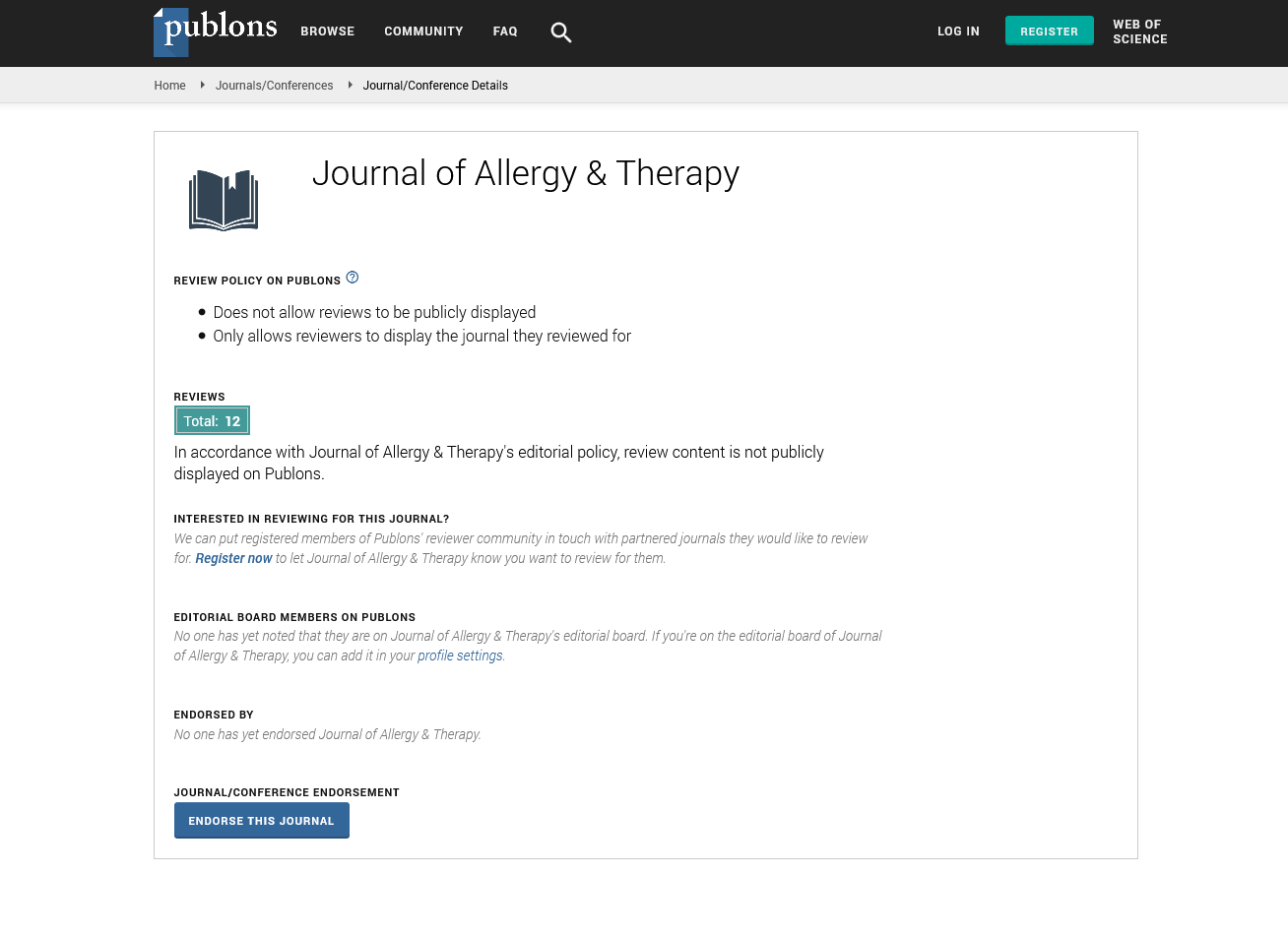Indexed In
- Academic Journals Database
- Open J Gate
- Genamics JournalSeek
- Academic Keys
- JournalTOCs
- China National Knowledge Infrastructure (CNKI)
- Ulrich's Periodicals Directory
- Electronic Journals Library
- RefSeek
- Hamdard University
- EBSCO A-Z
- OCLC- WorldCat
- SWB online catalog
- Virtual Library of Biology (vifabio)
- Publons
- Geneva Foundation for Medical Education and Research
- Euro Pub
- Google Scholar
Useful Links
Share This Page
Journal Flyer

Open Access Journals
- Agri and Aquaculture
- Biochemistry
- Bioinformatics & Systems Biology
- Business & Management
- Chemistry
- Clinical Sciences
- Engineering
- Food & Nutrition
- General Science
- Genetics & Molecular Biology
- Immunology & Microbiology
- Medical Sciences
- Neuroscience & Psychology
- Nursing & Health Care
- Pharmaceutical Sciences
Opinion Article - (2022) Volume 13, Issue 12
Small Airways and Bronchial Hyperresponsive in Cough-Variant Asthma
Kerrilyn Diana*Received: 28-Nov-2022, Manuscript No. JAT-22-19231 ; Editor assigned: 02-Dec-2022, Pre QC No. JAT-22-19231 (PQ); Reviewed: 16-Dec-2022, QC No. JAT-22-19231 ; Revised: 23-Dec-2022, Manuscript No. JAT-22-19231 (R); Published: 30-Dec-2022, DOI: 10.35248/2155-6121.22.13.321
Description
Asthma is a heterogeneous illness disease characterised by fluctuating expiratory airflow limitation, persistent airway inflammation, and Bronchial Hyper-Responsiveness (BHR) to a number of stimuli. Based on the characteristics and intensity of the respiratory symptoms, "Classic Asthma (CA)" is defined (wheeze, shortness of breath tightness and cough).
Glauser provided the initial definition of Cough Variant Asthma (CVA), which was further expanded upon by Carrao and McFadden in 1972, 1975, and 1979. They discussed asthma patients whose only presenting symptom was cough, but whose symptoms improved when only bronchodilators were used. The European and American recommendations do not specify precise diagnostic standards, but they do emphasise the diagnostic usefulness of BHR and suggest that the diagnosis of CVA be based on the effectiveness of the treatment. The 2016 Chinese Cough recommendations include BHR and successful use of bronchodilators and inhaled corticosteroids as the basic diagnostic criteria. The detailed diagnostic criteria and treatment of CVA are also taken into consideration.
Bronchial tubes with an interior diameter of less than 2 mm were considered small airways. Despite being implicated in half of all instances of asthma, they played a part in the pathobiology of the disease and have a unique role in certain disease phenotypes. Additionally linked to inflammatory changes and functional changes in the small airways were asthma severity. As a potential target for the best asthma control, the tiny airways are becoming increasingly understood to have a role in the disease. The purpose of this study is to investigate the reliability of BHR and small airways in the diagnosis of CVA.
The only presenting sign of CVA is chronic cough. Previous research has shown that women are more likely than men to experience chronic persistent non-productive cough, and they are also more likely to be bothered by the symptom. Patients at specialised respiratory clinics tend to be more female than male. Females have a higher threshold for coughing than males, as shown by the fact that their cough sensitivity is lower. The gender difference in our study is minimal.
Spirometry is the most extensively used non-invasive, simple diagnostic technique for determining the airflow restriction linked to asthma. Evaluation of proximal airway obstruction typically involves the use of parameters like FEV1 and PEF.
Until recently, it was believed that central airways were largely affected by asthma. Surgical lung samples from patients with chronic asthma who were still alive and postmortem samples from patients who died from asthma, however, show mucus plugging and inflammatory involvement of both the small and large airways. An inflammation in the small airways that was comparable to the inflammation in the central airways and was characterised by elevated T lymphocytes, activated eosinophils, and major basic protein. In comparison to the central airways, the tiny airways may experience inflammation that is significantly more severe. These findings demonstrate that the entire lung, ranging from the big proximal to the small distal airways, is affected by the chronic inflammation associated with asthma.
The pathophysiological characteristics of CVA and CA are comparable. Similar amounts of eosinophilic airway inflammation are seen in CVA, but the remodelling of the airways, including subepithelial thickening, goblet cell hyperplasia, and vascular proliferation, is less severe. Due to its ability to indicate the possible severity of airway obstruction, the maximal airway response on the dose-response curve is a component of BHR that is clinically meaningful.
Citation: Diana K (2022) Small Airways and Bronchial Hyperresponsive in Cough-Variant Asthma. J Allergy Ther. 13:321.
Copyright: © 2022 Diana K. This is an open access article distributed under the terms of the Creative Commons Attribution License, which permits unrestricted use, distribution, and reproduction in any medium, provided the original author and source are credited.


